°Arcus°
Home » Creation stories » California
CREATION STORIES FROM CALIFORNIA
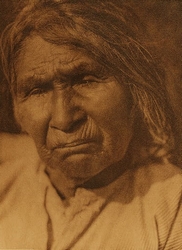
ACHOMAWI
In the beginning, all was water, beneath a clear sky. At one point, a cloud formed and, growing and condensing, transformed itself into Coyote. This was followed by a fog which turned into Silver-Fox. These two proceeded to think various things into existence, first of which was a canoe. In this, the pair floated about for many years until they tired of the canoe, which was becoming old and covered in moss.
Silver-Fox told Coyote to lie down, and he did so, falling into a deep slumper. Silver-Fox combed Coyote's hair, saving the many hairs which came out during the process. These he rolled in his hands and stretched out, making them flat. He placed this on the surface of the water and spread out this furry mass. The, thought he, there ought to be a tree, and there was a tree. Silver-Fox continued thinking of what should be found on the surface of this new land. In this way, Silver-Fox brought the dry land into being.
"Wake up," he shouted, "we are going to sink!"
At this, Coyote awoke suddenly, and, gazing up, saw cherries and plums hanging above him. He heard the crickets chirping. He asked where they were and Silver-Fox - not wishing Coyote to know that he had created the world - replied that he didn't know, that they had just floated up to the shore.
They landed and built a sweat lodge to live in at 'texcag-wa. They made living things from sticks of wood which they thrust into the roof of the house, which became people and animals. Pine-Martin and his sister Eagle were the chiefs of the people.
CAHTO
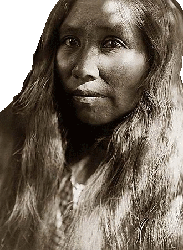
In the beginning, Kit-ka'ositiyi-qa had a son, Raven, whom he instructed in his ways, so that he may serve as a creator. Raven duly fashions the world, but finds the result unsatisfactory. The earth is dry and dark.
Thereafter, Raven is told that light could be found in a far-away land, whereupon he travels there to steal it. In this house of light, he meets a young woman, who dwells with her father. There is also a child which cries and wishes to touch a bundle hanging from one of the walls. The child is given a bag but, after he tires of it, it floats away and vanishes throught he smoke hole into the sky. Once there, the bundle opens, scattering stars across the sky. A second bundle also floats away, releasing the moon, followed by a third, which yields sunlight. His work done, Raven flies off through the smoke hole.
Eventually, the sandstone from which the original sky was formed grew old and weathered, causing thunder in all directions. Nagaitcho and Thunder decided to rectify the situation. To do so, they stretch the sky in all directions and set about creating the visible world and bringing order to the cosmos.
CHUMASH
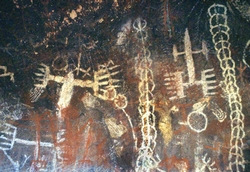
The world in which we live is the middlemost of three worlds. Below us is an underworld, while the sky world stretches out over us. These are the domains of two serpents and an eagle. The serpents dwell in the world below ours, and are tasked with holding out world up from below. Earthquakes result from their becoming tired and switching their positions.
The eagle, meanwhile, sustains the world above our own. The phases of the moon result from his stretching his wings when he tires of sustaining the upper world. Occasionally, he covers the moon completely, resulting in a lunar eclipse.
The upper world is also the home of Thunder and Lightning, who enjoy playing the hoop and pole game. One rolls the hoop, while the other chases it. This, of course, causes much uproar in our world, which we call thunder. Lightning, meanwhile, is the result of their throwing a light around. When it hits the surface of this world, it creates flint. This pair are also known to have descended to our world in past ages. On one occasion, Thunder sat down on the earth, causing the formation of a large hole which, filling with water, became Zaca Lake. The Sun, meanwhile, is a man carrying a torch of rolled bark across the sky, after which he snaps the torch, which results in sparks flying which are the stars.
Our world is also home to a host of frogs, whose urine produces the fresh waters of the earth.
KUMEYAAY (TIPAL-IPAY)
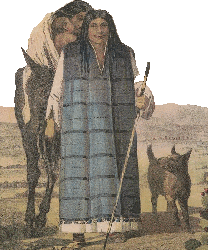
The Kumeyaay or Tipal-Ipay people of California, formerly denoted by the term "Diegueño," regard the universe as the work of Tu-chai-pai.
In the beginning, Tu-chai-pai made the Earth and Sky. Earth was female and Sky male. The latter, wishing to join his sister, came down to cover the earth, which was, at this stage, but a lake covered with rushes.
Thus, Tu-chai-pai and his brother found themselves in a very claustrophobic enviromnent.
To rectify this situation, Tu-chai-pai took some tobacco and rubbed it, before blowing thrice upon it. This caused the Sky to rise a little. Next, both brothers blew and uttered incantations, which caused Sky to go all the way up.
Next, the brothers made the four directions and, realising that people were coming, they made the hills and valleys, covering them with trees, plants and sources of water.
Tu-chai-pai next announced the creation of humanity. He gathered mud and made the Indians and then the Mexicans. He found women more a challenge than men. He told the people that they would not die, but would walk constantly, apart from during the night time, when they slept.
The people saw the light of the sun and were happy. Tu-chai-pai's brother then made the moon. When the moon got small, the people were told to run races.
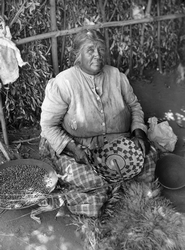
KUUPANQAXWICHEN (CUPEÑO)
In the beginning, all was dark and empty. Within the midst of space, there hung a bag, from which emerged Coyote and Wild Cat.
The pair struggled for primacy, a contest only settled when it was Coyote's voice that was heard by the formless humans dwelling in the void. At the sound of Coyote's voice, they rose up and sang sacred songs.
MAIDU
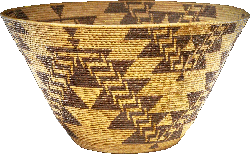
In the beginning, everything was dark, with the primordial waters in every direction. From the north, there came a raft, containing two entities. These were Turtle and Father-of-the-Secret-Society. They were caught in a fast-flowing current. Above them, from the sky, a rope of feathers descended, down which came Earth-Initiate. At the end, he tied it to the raft and stepped in. His face was covered, but his body shone.
Eventually, Turtle and Earth-Initiate strike up a conversation, and Turtle agrees to dive to the bottom of the ocean to retrieve something with which to form land.
Six years later, he returned, covered in slime. By this stage, the earth had been washed away, with only a small residue remaining beneath Turtle's nails. Earth-Initiate carefully scraped this out and put it in the palm of his hand. This he rolled into a spherical shape, about the size of a small pebble. He laid it on the stern of the raft.
He looked at it four times. The third time, it had grown and, by the fourth instance, was huge. The raft ran aground in a mountainous continent at a place called Ta'doikö.
Thereafter, humans and animals were created.
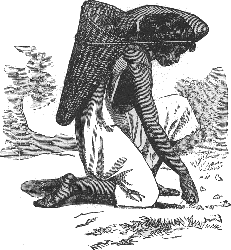
MIWOK
At the beginning of this phase in the history of the world, there was no land apart from a mountain top, where a few people from the previous creation found refuge from the deluge which had overcome that world. They tried to descend after the waters receded a little, but found the land muddy and treacherously soft, causing some among their number to sink without trace.
However, an interesting thing occurred at the site of these catastrophes: at each hole, a raven would alight and stand upon that spot. As the ground hardened, these ravens were transformed, becoming humans. Their raven heritage explains the dark skin tones of the Miwok.
NISENAN (SOUTHERN MAIDU)
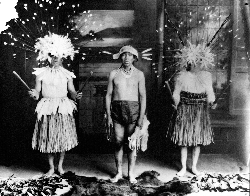
The Nisenan or Southern Maidu name the first people created by Coyote as Aikut and Yototowi. Yototowi became sick and died, so Aikut made a grave for her by his camp fire. He sank into a deep depression, wanting to join Yototowi in death, until her ghost arose and stood beside him, leading him on a hourney to the dance-house of the ghosts. This was through a vast, dark land, beyond a river. Crossing the river was a bridge made from one rope so thin that even Spider would struggle to cross it. Here, Yototowi's spirit made her way across alone. Aikut, however, stretched out his arms, causing her to return. She started again, when he spoke to her. When a living person speaks to a ghost, he or she dies. Thus, the pair were able to cross the bridge of rope together to enter the realm of the dead.
PAYÓMKAWICHUM (LUISEÑO)
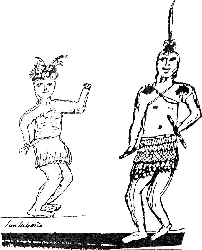
In the beginning, there was only the primordial void of Kevish-Atakvish or Omai-Yamal. Within this, things began to fall into shape. The Milky Way emerged, but there was no other source of light.
Kevish-Atakvish created a man, Tukmit, and a woman, Tomaiyovit, who became sky and earth. They conceived the first elements of creation, giving shape to the surface of our planet. From the earth arose the terrifying meteor Takwish and his son Towish, the immortal soul of humans. The people were derived from another who appeared at this time, Wiyot.
In order to address the darkness, Tomaiyovit made a sun, but it was so bright that it terrified the people and had to be hidden away.
Yet more people came into being, following the earth as it stretched to the south, where they came to Temecula, where Tomaiyovit again brought out the sun. This the people raised into the sky, where it follows its course and does not cause the terrors it had.
Temecula also saw the death of Wiyot, as a result of the hatred of Frog, who poisoned him for having given her such odd legs. Before dying, Wiyot taught the people all they needed to grow. He was cremated in the spring, and a great oak sprung from his ashes. Wiyot himself became the moon.
The Payómkawichum, these "People of the West," thereafter enjoyed an idyllic lifestyle beside the ocean, feeding on the plentiful seafood resources at their disposal there. They revered the Great Spirit, represented by the sun, as well as Uu-yot (Wiyot), the god of war and their tribal leader.
One day the Great Spirit wished them to travel into the land of the rising sun. Boats were made and many set out to begin the voyage in search of this new home. Uu-yot led them eastward, through a good deal of heavy fog, along the San Luis River.
They eventually reached a canyon with broad meadow and woodland on either side of the river, where they set up camp. Eventually, Uu-yot declared this an ideal location for their new home, and they founded a village, after which they feasted in thanksgiving long into the night.
Eventually, however, a great storm and a period of deep darkness overtook the area. Uu-yot saved the people by guiding them to higher ground.
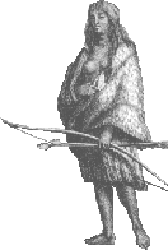
PERICÚ
The Pericúes were the aboriginal inhabitants of the extreme southern point of Baja California. Their culture survived from very ancient times into the 18th century.
According to Spanish accounts, the Pericú revered a figure by the name of Niparaya, esteemed as the creator of heaven and earth. By his wife Amayicoyondi, Niparaya was the father of three sons. One, Quaayayp, is credited with the making of humans, only for his creation to later kill him. The second son was Acaragui and the third was variously named as Tuparan or Wac.
POHONICHI
The Pohonichi tell of a primordial earth covered in water. Coyote looked about and saw ducks, one of which, the yimeit was tasked with diving. Eventually, after a number of attempts, it succeeded in bringing up some of the earth. Coyote took it and sent the yimeit down for chanit seeds. These he mixed with the mud to create the earth. This swelled and displaced the water, becoming the world we know today.
POMO
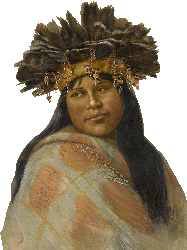
The Gallinoméro told of a thick, deep darkness which existed at the beginning of time. The animals were present, though, given the lack of light, they were constantly bumping into one another. Among their number was Kunula or Coyote. After much deliberation, Kunula found his way to a swamp, where he discovered a number of dry tulle reeds, from which he fashioned a ball, which he gave to Hawk, along with some flints. Hawk flew up into the sky and ignited the ball, which formed the sun. Kunula made another bundle, and again Hawk set off for the sky, in order to bring illumination to the night. The reeds were, however, rather damp this time, meaning that the moon was less bright than the sun.
Kunula went on to have children, and he and Cougar collaborated in the creation of a game for their offspring, which resulted in the deaths of many of Kunula's sons. The last two chased a ball into a sweathouse, only to be killed by the spiritual sun, who was then residing there. Kunula retrieved the corpses of his two sons, which he placed in a bag. Once this was opened, light emerged, leading to the creation of the physical sun and moon.
Humans came into being as a result of Kunula, who was in a sweathouse with Hatanutal (Lizard). Kunula made humans by placing sticks of willow and dogwood upright in the dirt. The humans into which these sticks transformed, however, had paws instead of hands. Kunula then placed hemp around them, which became fleas which leapt upon the humans. Hatanutal then suggested that these people might find hands rather more useful than paws, which resulted in Kunula challenging him to a bout of wrestling. Hatanutal prevailed, resulted in humans receiving their hands, as well as language.
Eventually, the world became the domain of six groups of spirits, living in the four cardinal directions, as well as above and below: -
- Guksu or Kuksu in the south;
- Calnis in the east;
- Suupadax in the north;
- Xa-matutsi in the west;
- Kali-matutsi in the heavens; and
- Kai-matutsi on earth and beneath.
Gallinoméro legends posit two destinations for the souls of the deceased, with the good people going to the Happy Western Land beyond the Big Water and the destination for evildoirs being a desolate island in the Bitter Waters.
Another Pomo myth focusses on two brothers, Kuksu and the Old Man Madumda. Madumda created the world having got advice from Kuksu.
SALINAN
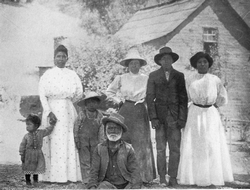
In the beginning, Eagle was the most powerful of beings. Sea Woman grew envious and sought to drown the land with the waters, which left only the summit of Santa Lucia Mountain above sea level.
Eagle gathered the animals there and used Puma's whiskers to fashion a lariat, with which he captured the basket which contained the seas. Sea Woman died and Dove was dispatched to bring up some mud. This was used by Eagle to form a new world.
Eventually, he created a man and woman from the wood of the elder, but they needed to be taken to a sweat lodge by Prairie-Falcon. The breath of life was conferred upon them there by Eagle.
SHASTA
Long ago, the world was so new that even the stars were yet to shine. It was a flat plane. Chareya, Old Man Above, was unable to see it within the darkness, nor could he find a way down to this new earth so far below him. He began to bore a hole in the sky, through which he pushed down show, which formed a pyramid above the plain. He climbed through and stepped from cloud to cloud, until he reached the pinnacle of the mound of snow.
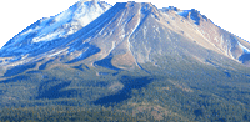
The sun shone through the hole he had made in the sky, melting the snow. Once on the surface of the earth, Chareya poked his finger into it and planted the first trees, which were watered by the meltwater from the snow. He then gathered leaves and blew upon them, creating birds, and broke a stick to make the land mammals. The grizzly bear was made from the end, the remainder from the middle. Grizzly was strong and wily and carried a large club, walking in a bipedal mode. Chareya began to fear Grizzly, so he hollowed out the snow and ice, forming the first tipi, in which he lived for many years. The humans knew he was there, as they could see the smoke emerging at the top. However, one day, he left. Thus, there is no more smoke coming from the top of the tipi, which is known today as Mount Shasta.
OLD MOLE
Even before there was any earth, creation was afoot. Old Mole burrowed beneath Somewhere, throwing up the soil which became the world. Humans were then fashioned by Great Man. They were cold, so asked Coyote to fetch the Fire Stone from the east. This he did, bringing the knowledge of fire.
Coyote also killed the nine brothers of the sun, for they were all identical and their combined heat was threatening to burn up the earth. Moon also had nine brothers, made of ice like himself. Coyote killed nine of them in the east, thus saving the Night People from freezing to death.
Coyote was also responsible for the eruption of Mount Shasta in some legends, after he attempts to smoke out a swarm of hornets who were in the habit of stealing his salmon.
WIYOT
When Old Man in the Heavens made humankind, they were covered in fur. These displeased him, and he sent a flood to destroy them. Somehow, however, Condor got wind of this, and fashioned a basket which served as an ark in which he and his sister survived.
After a while, during which they were floating blind, they made a hole, through which they saw a land populated by all manner of life. Condor and his sister then became mates and caused the generation of the first humans as we know ourselves today. These proceeded to multiply.
YANA
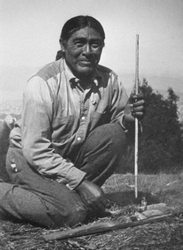
Once, Pun Miaupa fought with his father and fled his home to seek refuge in the house of his uncle, a shaman. He told his uncle that he wished to win Halai Auna, the morning star, as his bride. The uncle, however, knew that Halai Auna's father, Wakara (the moon) was a cruel fellow, and sought to dissuade Pun Miaupa from pursuing this course of action, but to no avail. This led the shaman to enter Pun Miaupa's heart to protect him.
Wakara seemed welcoming, but used magical means to try to bring about Pun Miaupa's end, teleporting his family to the home of Tuina, the sun, and owner of poisoned tobacco which Wakara hoped would kill his daughter's suitor. The shaman, however, managed to rescue Pun Miaupa, by sending a flood, which drowned everyone bar Halai Auna. She, however, was distraught, which led the medicine man to reluctantly restore the deceased to life.
The scene then transferred back to Wakara's house. A tree-bending contest was joined, and was won by Pun Miaupa with the aid of his uncle. The young lovers were married and Pun Miaupa pronounced a doom on Wakara, that he was to remain in the sky, growing old and young by turns.
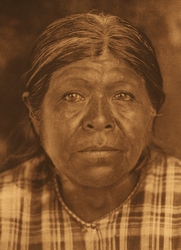
YOKUTS
The Yokut believe that this current earth emerged in the wake of a great flood. One day, an Eagle with a Crow on its back searched for a place to land. Eagle found what appeared to be a tree stump and landed there to rest. They eventually set out again in search of land, but, finding none, tried to think of a way forward. Eventually, the had Duck go to the bottom of the sea and bring up mud, with which the world was made. The Gashowu call this duck K'uik'ui, and say that the first attempt had been made by its relative, Potikh. Other accounts replace the primordial animals with others, such as a Falcon and the ever-popular Coyote.
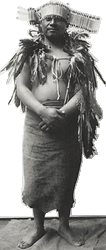
YUKI
In the beginning, Taiko-mol (Solitary Walker) made the earth. He emerged from foam on the surface of the primordial ocean, heralded by a voice. On his head were the feathers of an eagle.
Taiko-mol stood on the foam and sang creation into being. He made a rope in the darkness and laid it out on a north-south axis, before walking along it and creating the earth behind him as he moved. He repeated this action four times, an on each occasion the water soon engulfed the new land.
In order to stabilise the land, he made four stone pillars and placed them at the cardinal points, before attaching ropes to these and stretching them across the world. He spoke the Word and the earth came to be. He secured it from being overwhelmed by use of whale skins. He shook the earth to check its stability, thus creating earthquakes, which happen when he periodically re-tests his creation.
